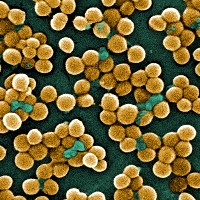
Scanning electron micrograph image of MRSA bacteria (Janice Haney Carr, Centers for Disease Control and Prevention)
University of California in Los Angeles received a $2.5 million grant from the Agency for Healthcare Research and Quality for a clinical trial to test the use of copper to decrease the number of hospital-acquired infections. The research team will be led by the university’s Sustainable Technology and Policy Program and include members from UCLA’s medical, public health, law, and engineering departments.
Health care-associated infections are a huge public health burden, and hospital environments can harbor potentially deadly bacteria such as E. coli, C. difficile and methicillin-resistant Staphylococcus aureus (MRSA). The Centers for Disease Control and Prevention says 1 of 20 hospitalized patients will contract an infection an infection from their stay.
Copper surfaces are not normally used in hospitals, but copper is known to kill bacteria on contact. UCLA says where copper has been used in hospitals, studies have found lower levels of bacteria living on those surfaces than on standard hospital surfaces.
For the clinical trial, two intensive care units at UCLA’s medical center will be outfitted with copper surfaces, as well as sham stainless steel and conventional surfaces such as plastic or other types of coatings. Hospital surfaces selected for the study will include bed rails, chairs, a bedside table that can also be positioned on top of the bed, and a mobile treatment cart-top used by nursing staff that includes handles, computer keyboard, and a mouse. Over a four-year period, all three types of surfaces — copper, stainless steel, and conventional plastic — will be sampled for bacteria levels, and patient-infection outcomes rates will be compared among the three surfaces.
The research will include additional environmental microbiologic studies and evaluations of surface cleaning, as well as a detailed cost–benefit analysis. “We will be studying if lowering the level of bacteria on hospital surfaces results in reduced infection rates in patients, better outcomes, and even lower costs,” says the project’s principal investigator, Daniel Uslan, a professor of medicine at UCLA.
Read more:
- Daily Bathing of Elderly Sharply Reduces MRSA Infections
- Tracking Antibiotic Use Reaps Big Hospital Cost Savings
- Antimicrobial Scrubs Can Help Reduce MRSA Risk to Patients
- U.S. Patent Granted for Anti-Microbial Polymer Technology
* * *

 RSS - Posts
RSS - Posts
[…] UCLA to Study Copper Surfaces to Reduce Hospital Infections […]
[…] UCLA to Study Copper Surfaces to Reduce Hospital Infections […]